
The farm is a quiet place lately. The last successions of lettuce and root crops are in the ground, and now instead of planting we are focusing on harvesting and starting the annual process of putting the farm to bed. The winter squash are peeking out bright orange and green behind their browning vines, the corn stalks are drying, rustling gracefully in the autumn breeze, and the finches are plucking out the seeds from the last sunflower heads. There is more spaciousness to the work, not the frantic pace of “getting everything into the ground in time” of the spring, but a slow steady rhythm of abundance.
The fall tasks tend toward stocking up for the winter; preserving everything possible in order to savor some summer sweetness in January. On Sunday Chris and I made four gallons of the Sicilian spread caponata. I had never tried caponata, but Chris promised it was well worth all the effort of dicing, and so we began. We got up early and cut up tomatoes, peppers, eggplant and onions into tiny pieces, fried them in olive oil and threw all those glistening jewel-colored bits into a big pot. The pot simmered on the stove, filling the house with savory, mouth-watering smells. We listened to loud music as we chopped and rambled on about whatever popped into our heads. It was a good four hours to get everything into the pot but felt like the right way to spend time, in the tradition of slow food and Italian grandmothers. By the late afternoon the caponata had cooked down into a thick, chunky sauce and we took it still warm to the river to enjoy on crusty baguette with good friends. It was such a satisfying process and a timely reminder of what life had been and could be, focused on feeding and sheltering yourself and your loved ones with tangible effort, rather than having a job in order to buy those things.
This is why I love fall, and why I love farming. The abundance that comes at the end of the season, and the lifestyle that includes preparing and eating food with family and friends. When I encourage people to buy local and organic foods, besides all the myriad health and ecological reasons, the incredible flavor and pleasure of eating is probably the most compelling to me. The slow food movement recognizes and celebrates this and I encourage y’all to look into it more here if you haven’t heard about it. I hope you are able to spend some slow, pleasurable time enjoying this week’s share, and I’ll see you on the flip side.
love, Willow
Anticipated harvest:
lettuce
kale/collards/chard
boc choi/tatsoi
tomatoes
eggplant
peppers
corn
carrots
summer squash
cucumbers
parsley
Here’s the caponata recipe we used, courtesy of Susan Shehab (Chris’s mom)
2 large eggplants, diced
1 cup olive oil
4 bell peppers, diced
1 large onion, diced
6 ripe tomatoes, peeled, seeded and chopped
1/2 cup green or black olives, pitted and sliced
3 hearts of celery, chopped
1/4 cup capers (the celery & capers are important)
1/2 cup wine vinegar
1/2 cup water
1 teaspoon sugar
Salt and pepper
Brown the eggplants in half of the oil. Remove.
Add more oil if necessary & when hot – add
Peppers – cook ’til wilted & remove.
Now, sauté onions ’til wilted then add
Tomatoes & simmer ’til they are reduced to sauce.
Add olives, celery, capers; simmer a few minutes
Then add wine vinegar, water, sugar, cooked peppers
& eggplants. Season with s/p and cook over low heat
’til vegetables are well cooked and sauce thick (30 minutes).
If you are canning: process in hot water bath as follows:
1/2 pints for 20 minutes boil
pints for 40 minutes boil
Serve at room temp on small pieces of good bread
With a sprinkling of grated cheese. Enjoy! Love, Mom
And in case you haven’t already had an eggplant parmesan (a favorite way of mine to eat eggplant and tomatoes) here’s a nice twist on this traditional dish.
Eggplant Parmesan (adapted from Joy of Cooking)
The eggplant is normally baked in a single layer with sauce and cheese, but in a pinch you can feed more people in one pan if you do it lasagna-style in layers. Serve over angel hair pasta.
Sauce Ingredients:
- 5-7 large tomatoes, finely diced
- 1/2 cup fresh basil, finely chopped
- 2 cloves garlic
- 1Tbs olive oil
- 1 tsp salt
Casserole Ingredients:
- 4 medium eggplants (about 4 pounds), cut in 1/2 in. thick slices
- 2 eggs, beaten
- Olive oil, for frying
- 2 cups shredded Parmesan cheese (about 8 oz)
- 2 cups shredded mozzarella (use fresh, water-packed mozzarella if you can)
1. Preparing the Sauce:
Dice the tomatoes and put them in a colander in the sink. Let them sit for about 20 minutes, so that all the extra liquid drains out. In the meantime, chop your basil and garlic. You’ll have some extra time to use up here, so start slicing your eggplants up. When the tomatoes are drained, mix them in a bowl with the basil, salt, garlic, and olive oil and let it all marinate.
2. Frying the Eggplant:
Heat about a tablespoon of olive oil in a frying pan. (Or, if you’re coordinated, I recommend doing two pans simultaneously, to save time.) When the oil is hot, lower the temperature to medium. Briefly dip each slice of eggplant in the egg and shake off the excess, then toss it in the pan. Cook for 2-3 minutes on each side, until it is soft. Put the cooked slices on a platter off to the side.
3. Assembling the Casserole:
Preheat your oven to 350°. Spread about 1/3 of the sauce in the bottom of a large baking dish. Lay slices of eggplant on top, with edges touching. Sprinkle about half the Parmesan and mozzarella cheeses over the top, then add another layer of sauce and another layer of eggplant. Spread the remainder of the sauce over the top, then finish off with the rest of the cheese. Bake for about 20 minutes, until the cheese is melted and the casserole is heated through.





